While ingrown hairs and folliculitis are not dangerous, they can cause severe pain and discomfort. These problems can be prevented by not shaving the hair on the stump.
.jpg)
Prosthetic inlay under the dental crown: costs
A denture inlay is a structure made of metal or ceramic that is used to preserve a severely damaged dental crown (before a denture crown is placed on the tooth). The creation of inlays under the crown allows the preservation of teeth whose crowns have decayed up to 100 %. The only requirement is a strong root that can withstand chewing pressure.
Such inlays under the crown are also known as pin inlays or cast inlays. The appearance of core-built-up inlays suggests that they consist of two parts – an intracanal and a supracanal. The core build-up inlay has a post that is cemented into the root canal. The inlay has the shape of the stump of a crowned tooth onto which an artificial crown can later be placed (Fig. 1-3).
Inlays on a crowned tooth: photo.
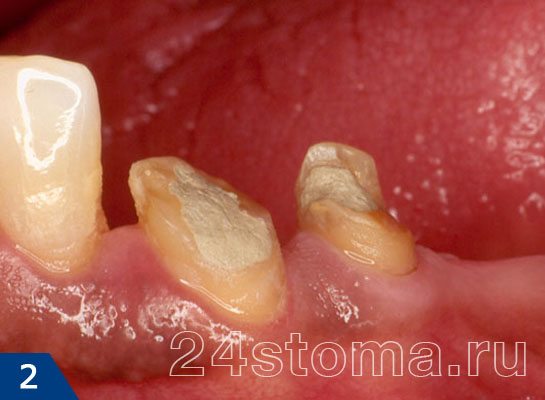
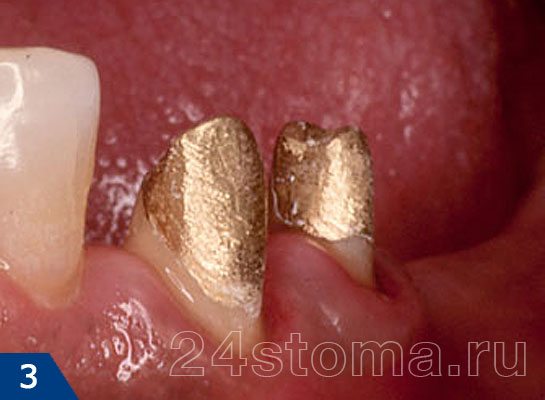
Endodontic inlays under the crown are a high-quality alternative to traditional restorations with a conventional inlay (metal or fiberglass) and filling material. It makes a big difference, especially if the dental crown is severely damaged, as it allows for a much longer lifespan and also reduces the risk (e.g. of a root fracture).
Why are inlays needed?
Why do dentists prefer to replace severely damaged teeth with posts and fillings rather than with core restoration? The fact is that, as a rule, the patient first goes to the general dentist, who treats all teeth, and only if necessary refers the patient to an orthopedic dentist (prosthodontist). In this case, the orthopedist is unlikely to recommend removing the already paid filling and post from the root canal and paying again - just to have an inlay placed under the crown.
The second problem is that a patient who has chosen the most budgetary option, namely metal-ceramic crowns, 6,000 rubles more for a pin can lead to him completely refusing prosthetics. Most patients are not willing to pay for reliability, that is, for something that has not yet happened (for example, loss of a crown with an inlay or breakage of a tooth root). As a rule of thumb, a tooth can only be treated with a conventional inlay and a filling for a crown if there is still enough hard tissue in the tooth (Fig. 4-6).
Crown restoration with inlay and filling -.
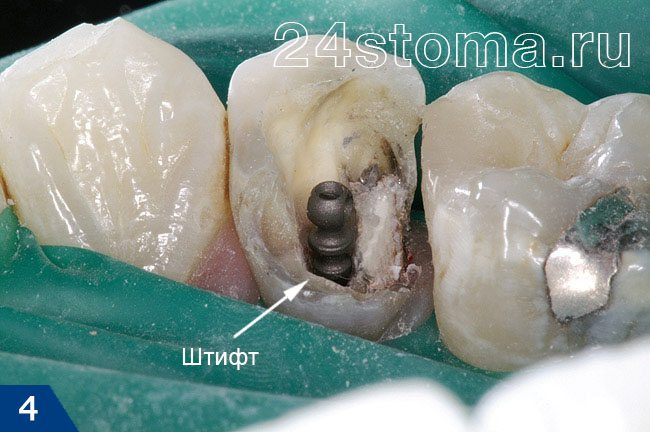
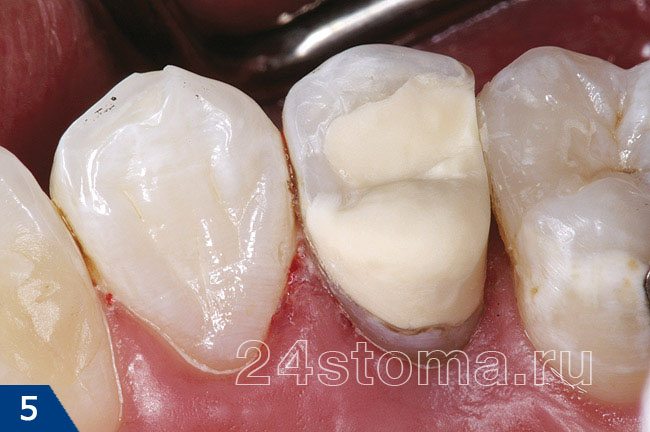
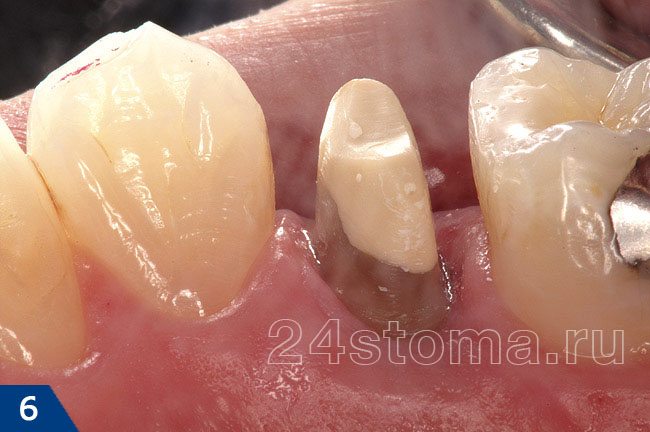
Important! However, if the tooth has only one root or very thin walls, fitting it with a post is associated with two complications. First, the root cannot withstand chewing pressure and breaks (root fracture), requiring extraction.
Secondly, with this type of treatment it is common for the crown and post with the filling to fall out. In this case, it is not possible to simply reinsert the fallen crown and post into the root canal. The tooth would have to be completely re-treated and a new crown would have to be made, which would involve new costs. Some doctors' attempt to put the crown back in and cement the whole thing together results in either the new tooth falling out or the tooth under the crown beginning to rot.
Wounds
Pressure ulcers develop at pressure points and where the skin is exposed to lateral (lateral) forces, especially in the presence of moisture. Common sites for pressure and cutting injuries include bony prominences, the edge of the prosthetic socket, and the distal portion of the stump.
The first sign of skin damage is erythema, which may be accompanied by pain, swelling, blistering and ulcers. The skin that comes into contact with the prosthetic socket must be carefully protected and monitored to avoid skin damage and skin infections. Pain is the first symptom. Read more .
Although skin breakdown cannot be completely prevented, some measures can help prevent or delay it:
Stump hygiene (morning and evening): Wash the stump twice daily with a mild soap solution and rinse thoroughly (more often for patients who sweat profusely). The prosthetist can provide specific antiperspirants for amputees.
Keep your body weight constant: This is the best way to be sure the prosthesis fits properly; even small changes in body weight can affect the fit.
Eating a healthy diet and drinking water throughout the day will help control weight and keep skin healthy.
If you notice signs of skin degradation, you should contact your dentist immediately to rule out poor fit as a cause and adjust the denture if necessary. If possible, patients should not wear the prosthesis until it is fitted. If the prosthesis is not the cause of the damage or if proper fit does not resolve the problem, a medical evaluation should be performed.
Skin infections
In normal, healthy skin, bacterial and fungal microorganisms are in balance due to the dry, undamaged epidermis. However, the stump is encased in a sheath, a type of viscoelastic gel or plastic layer that creates a warm, moist environment that promotes bacterial and fungal growth and infection. Wet skin also tends to crack, allowing bacteria to easily enter the body. The result is the spread of the infection.
Symptoms of infection include soreness, redness of the skin, pimples, ulcers or necrotic areas, and purulent discharge. An unpleasant smell can indicate an infection or poor hygiene. A mild bacterial infection can develop into mucus. Phlegma is an acute bacterial infection of the subcutaneous skin, usually caused by streptococci or staphylococci. Symptoms and signs include pain, hot flashes, and rapidly spreading illness. A skin abscess is a localized collection of pus in the skin that can develop anywhere on the skin. Symptoms and signs of this condition include pain and the formation of painful. Read on, in such cases patients may experience fever and general malaise.
Any signs of infection should be investigated immediately. Patients should be advised that they should seek immediate medical attention if they experience the following symptoms:
Treatment for a bacterial infection usually involves cleaning the wound and administering topical antibiotics. Sometimes surgical treatment of the wound, oral administration of antibiotics, or both is necessary. As a rule, the prosthesis should not be worn until the skin infection has healed. Erythema may indicate a serious medical problem; in this case, medical diagnosis and therapy is required.
In narrow circles
Although small groups of people with particular interests cannot be considered full-fledged cults or even anything similar, the adjective 'cult' has become commonplace for them. It is a name for something that is very familiar to relatively small groups of people. For example:
That is, the meaning of the word 'cult' suggests that the character, performer or author mentioned is not the idol of millions of people, but is considered a legend in certain groups.
Features of trailers
The American psychologist Steven Hassen has studied cults for 25 years. The author characterizes them as follows: 'Recourse to deception and mind control methods to weaken a person's free will and make him dependent on the group leader'.
It can be concluded that followers possess the following psychological characteristics:
- suggestiveness;
- weak willpower;
- lack of self-confidence;
- tendency to dependency, subordination;
- victim mentality;
- low level of intelligence, narrow-mindedness;
- Passive attitude to life;
- uncertainty, lack of personal plans;
- Personal immaturity, lack of stable views, beliefs and values.
A cult is a sect. It is led by a person, a group of people or an organization. In any case, the followers in this context become pawns in someone else's game. Of course you have to defend yourself against this.
Unmasking
The main difference between a cult is that its ideas are not subject to critical evaluation. Leaders prohibit their followers from thinking differently and questioning the ideas imposed on them.
The leaders call themselves by different names: elder, guru, mentor, teacher, prophet. They ostensibly lead people to the truth, but they completely block the autonomy of the 'disciples'. You simply tell them what to do and how to think to be happy. It is questionable whether this makes a person happy. Most of the time that is not the case.
The cult controls the mind of the follower. The information given, personal time, behavior, emotions and feelings are controlled.
It is possible to expose or at least suspect a cult through the following plan:
- Is the information not passed on in full? Is something only accessible to special initiates? Does the information depend on the level of initiation?
- The organization divides the world into good and evil, black and white, with evil and black being everything outside?
- The leaders prohibit the rest of the members from communicating with those who have left? Those who left are considered losers, sinners or traitors? Active members are not allowed to ask others why they left?
- Is no other literature, including oppositional literature, allowed to be read in the organization? Do the leaders themselves distribute books to broaden horizons and exclude critical discussions and polemics?
- Meetings, prayers, sermons and reading literature take up the entire time of the followers? Does the organization's management control compliance with ideas, does it encourage whistleblowing to other participants?
- Is the idea of fear (losing salvation, free thinking, being exposed to external evil) cultivated? Are participants made to feel guilty about personal inadequacy, about the inability to achieve an ideal?
- Is the idea being cultivated that group membership and obedience are better and safer than personal decisions, opinions and enforcement?
last comments
- Abakan fishing ban
1 week 19 hours ago - Come back!)))
1 week 2 days ago - With great interest and
1 week 2 days ago - Very cool place. I was there
1 week 5 days ago - Thanks, corrected.
3 weeks 3 days ago - Hello. Unfortunately it's the last one
3 weeks 3 days ago - Well Chukotka – not really.
3 weeks 5 days ago - My grandfather Borisov Daniel.
3 weeks 5 days ago - Hello Akhat! Missing
3 weeks 6 days ago - An error has occurred.
4 weeks 5 days ago
Nomad Team Pilot…
Bortyakov Andrey
[email protected]
KULTEY BOLSHOI LAKE
.jpg)
Kultey Bolshoi Lake is located in the Nizhny Novgorod region.
The lake is medium in size, stretches from west to east and has the shape of an irregular concave oval from the north.
The eastern part of the bank is surrounded by steep, high banks which give way to marshland towards the western end.

The bottom of the lake is covered by a thick layer of mud, but there are convenient access points to the water.
At the eastern end of the lake there is a high, open area suitable for camping and offering beautiful views of the lake.
Below the bank is the 'Cultejski Spring', which was illuminated by the Church of Blagovski lesu on the occasion of the 2000th anniversary of Christianity.
There is a small sandy entrance to the water near the spring.
In the southwest there is a comfortable hut for overnight stays.
To the south lie the lakes Kultej Sredny and Kultej Maly, which are hidden in the swamps and difficult to access.
The Bolshoy Kultai Lake is located: from the district center of Vorotinets in the north 38 km, from the village of Raznezhje in the north 25 km, from the village of Kuzmijär in the northeast 15 km.
It is a complex natural monument. The protected area was established by Resolution No. 42 of the Executive Committee of the Gorky Region People's Committee dated January 26, 1978. The passport for the natural monument was approved by the Decree of the Nizhny Novgorod Regional Administration No. 79-p dated January 23, 1995.
Area of the natural monument: 23.9 ha; the protection zone is 38.4 ha.
Purpose: protection of the gene pool (rare animal species); Protection of the Cenofonds (biocenosis of the Aeolian Lake); water conservation; scientific (zoological, botanical).
Culta – term and meaning
Let's see what is meant by the term and the meaning of the word kultya (information provided by intellect.icu).
A stump is – 1. the remains of a mutilated or amputated arm or leg.
2. the remainder of a nerve, bronchus or appendage after it has been shortened or removed (in medical language).
A stump is the part of a limb that remains after an amputation or mutilation.
A stump is – 1. a stump, (in the person and m singular). Blunt.
-is, female, remnant of a mutilated or amputated arm or leg. He carefully removed the artificial limb and, holding his breath, panting and croaking, stroked the frozen stump. Pavlenko, happiness.
Part of a statement.
. under today's conditions Judaism in Russia Sources and Judaism Tanach Emergence of Monotheism Yahweh Cult Messianism Talmud Judaism is the religion of the Jewish people The word 'Judaism'; comes from . The ritual and social laws that . The children of Israel led the children of Israel during their wanderings in the desert. Worship and rituals had no special meaning for Moses, they were just an additional means of . (religious studies)
. world in a supernatural way. is called (name): Taboo Shamanism Totemism Magic Fetishism Ancestor worship is one of the best known (list):. Animistic cults Polytheistic cults. Nature National Character In the religions of the ancient world (name ) occupied a special place:. State cult Cult of a particular nationality Personality cult Ancestor cult Cult of a particular. (Religious Studies)
. Lectures Origin and development of Confucianism Confucian literature Confucius cult Social ideals Ancestor cult and 'xiao' norms;. ritual law 'zhen'; Consecration of Imperial Power Cosmogony. China, 'Lun Yu'; remains almost the only reliable testimony of the sage and his teachings Cult of Confucius Social ideals Ancestor worship and 'xiao' norms; . Rituals The law of 'zhen . (Religious Studies) .
. and wow. Ancient peoples of the Middle East, Central Asia and Egypt One of the most widespread cults among the peoples who inhabited these areas was that of the sun, light and most . (ethnopsychology)
. ) represent nothing other than a carefully crafted formulation of this. Coordinates Let's start with the body cult 'What is here is everywhere, and what . is not here, and what is not there is nowhere'. It is a clause of Vishwasar. to Sadhana, 'the way home'. The basis of tantric sadhana is still Deha Tattva, the worship of the human body. but their purpose is no longer 'supernatural powers' as such ;.more . (ethnopsychology)
Kultai

blunt A stump is the part of a limb that remains after an amputation (disarticulation), an injury, or due to a congenital defect.
The length and shape of the stump, the mobility of the adjacent joint, the strength of the muscles, the condition of the skin and the absence of pain are the most important factors that determine the formation of the stump. The amputation technique and the correct management of the postoperative period are of utmost importance to obtain a complete stump and its correct formation.
The best option for prosthetics is a stump in the middle third of the stump. Short stumps (less than 6 cm) are least suitable as they can pop out of the prosthetic socket and require additional anchoring. For the long version, the prosthesis must be more complex.
- Cylindrical (common in the early days after amputation).
- Club-shaped (occurs after amputation of the knee, ankle, elbow and wrist; complicates modeling of the prosthetic socket, but does not require fixation)
- conical (most suitable for modeling a rational prosthetic socket).
The final, more or less permanent shape of the stump is achieved 10-12 months after amputation. Physiotherapy, exercise therapy, massage, electrical muscle stimulation, etc. are used to correctly shape the stump.
If the prosthesis is not made or used properly, diaphoresis, abrasions, pus formation, etc. may occur on the stump. To prevent these diseases, good hygiene, proper care of the residual limb and prosthetic socket, and ensuring that the prosthesis fits correctly from the outset are essential [1].
The Mother Goddess
Cybele (other names are Cybele, Cybeba, Kubaba) is one of the oldest goddesses known to man. The great mother was already worshiped in the Neolithic period. The earliest information about their worship was found in monuments from the 2nd millennium BC. Found.
Cybele was originally worshiped by the inhabitants of Phrygia, an ancient state in modern-day Turkey. Compared to the Egyptian Isis and the Sumerian Inanna, she combined the characteristics of several ancient goddesses. Above all, Cybele was associated with Demeter, responsible for fertility and agriculture, and Rhea, the mother of Zeus.
The goddess was depicted as a tall and dignified woman wearing a cloak and having a crown on her head, and this royal headdress resembled a tower: tall and cone-shaped. Her symbols were always next to Cybele: a lion and a pine tree. The goddess held a tympanum, a percussion instrument, and a scepter or ears of wheat. All of these symbols represented the size of Cybele.

Originally coming from Asia Minor, the cult of the goddess quickly spread to neighboring states that were within the Phrygians' military, political and cultural sphere of influence. However, the peoples who worshiped Cybele often associated her with local female deities responsible for fertility. This was the case with the Celts, Hittites, Greeks, Romans and other ancient peoples.
The black stone of Cybele
It is interesting that in connection with the Cybele cult there is a black stone that is said to have fallen from the sky. It is probably a piece of meteorite. According to ancient authors, the face of a woman was imprinted on this small, irregularly shaped stone by nature itself. The believers believed it was the image of a goddess.
The revered relic was kept in the sanctuary of the Phrygian city of Pessinunte until the stone was discovered in 204 BC. B.C. was brought to Rome, where it was ceremoniously installed in the Victory Temple. The inhabitants of the Eternal City believed that Cybele would help them win the Second Punic War by defeating the Carthaginian army led by the famous general Hannibal. The Romans were soon defeated, and the cult of the Phrygian goddess was given official status.
The cult of the Phrygian goddess received official status. Because of the sacred stone, the Great Mother was popularly associated with the color black. The statue of the Madonna and Child, located in a temple in Chartres, France, is considered an image of the ancient goddess because this sculpture is also black. There are many similar statues in European temples.
It is worth noting that the tradition of worshiping meteorites (stones fallen from the sky) also exists in other religions. A Muslim shrine, for example, is the black stone Kaaba, which is located in Mecca.
Figuratively
In modern society there are rarely real cults with rituals and ceremonies. However, there are people and works of art that are so well known and respected that they inspire a special level of awe and admiration. For example, it could be a talented politician, an interesting film, a bestseller or an expensive painting. Such things could just as easily be described as iconic.

Here are some examples of using the word 'iconic' in this sense:
- 'Titanic' starring Leonardo DiCaprio is an iconic romantic tragedy.
- Ilon Musk is an iconic personality whose name is known to millions of people.
- 'Harry Potter' is an iconic book that multiple generations have grown up with.
In this case, the word 'iconic' means something like 'legendary', 'known to all', 'recognized worldwide'.
In narrow circles
Although small communities of interest cannot be viewed as full-fledged sects or even anything similar, the adjective 'cultic' has become commonplace for them. It is a name for something that is very familiar to relatively small groups of people. An example:
That is, this meaning of the word 'cult' suggests that the said character, performer or author may not be the idol of millions of people, but is considered a legend among certain groups of people.
Read more:- blunt.
- Colostomy - what is it?.
- acetabulum.
- prosthetic legs.
- Limb amputation.
- What to do with amputated limbs?.
- Leg prosthesis below the knee.
- The reamputation is.
